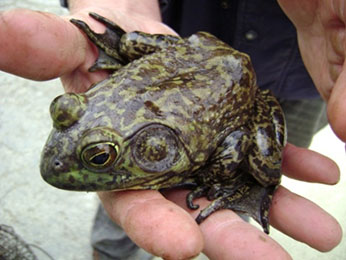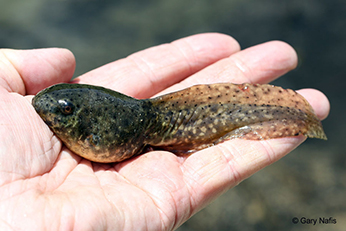(Lithobates catesbeianus)
General Description
 Adult American bullfrog in southern California. Photo courtesy of Kerwin Russell, Riverside-Corona Resource Conservation District.
Adult American bullfrog in southern California. Photo courtesy of Kerwin Russell, Riverside-Corona Resource Conservation District.
 American bullfrog tadpole. Photo by Gary Nafis, California Herps(opens in new tab).
American bullfrog tadpole. Photo by Gary Nafis, California Herps(opens in new tab).
American bullfrogs are large frogs with wide heads, stout bodies, and long, hind legs with fully-webbed hind feet. Bullfrogs have smooth skin which is green to brown in color on their backs, often with dark spots or mottling, and white to grey to yellow in color on their bellies, with or without mottling. Bullfrogs have large eardrums, or tympanum, which are larger in males (twice the size as their eye) than females (same size as their eye). Male bullfrogs can also be distinguished from females by their smaller body size, yellow throat, and deep, low-pitched mating calls bellowed during the breeding season. Adult bullfrogs can weigh over 2 pounds and measure more than 8 inches in length. Bullfrog tadpoles are green to yellow in color with small, dark spots on their backs, and can grow up to 6 inches in length.
Current Distribution
Although American bullfrogs have become widespread throughout California, they are rarely found in elevations above 7000 ft. in the Sierra Nevada Mountains. A few documented populations do exist in areas surrounding the greater Tahoe region where habitat is suitable for bullfrogs. Native to the central and eastern United States, bullfrogs are currently found throughout these areas, as well as within many areas of the western United States where they have been introduced, including Hawaii.
Habitat Preference
American bullfrogs occupy a wide range of both natural and manmade habitats, including lakes, ponds, swamps, marshes, brackish waters, streams, rivers, ditches, and canals. They prefer warm, slow or stagnant waters with abundant vegetation, but are also found along the shorelines of lakes and banks of streams. Bullfrogs are tolerant of cold temperatures and have the ability to hibernate in bottom substrates when temperatures fall below freezing.
Pathways
American bullfrogs were intentionally introduced into the western United States as a food source and for biological control of insects, and may have been accidentally introduced into some areas during fish stocking. They also likely spread to new areas when they escaped from frog farming operations and/or were released by pet owners. Bullfrogs continue to be introduced into the wild by escaping from or being released by laboratories, research facilities, and pet owners. Once in the wild, bullfrogs disperse to new areas by swimming or being carried by water flows.
Impacts
Adult American bullfrogs have voracious appetites and will eat anything they can fit into their mouths, including invertebrates, birds, bats, rodents, frogs, newts, lizards, snakes, and turtles. Bullfrog tadpoles mainly eat algae, aquatic plant material, and invertebrates, but they will also eat the tadpoles of other frog species. As a result of these feeding behaviors, all lifestages of bullfrogs prey upon and are able to out-compete native frogs and other aquatic species. Additionally, bullfrogs are a known carrier of chytrid fungus, which causes the potentially fatal skin disease in frogs called chytridiomycosis. Chytridomycosis is believed to be a leading cause of the decline of native amphibian populations all over the world and responsible for the extinction of over 100 species since the 1970s.
Actions Taken if Found
If you observe this species in California, please report your sighting to the CDFW Invasive Species Program, by email to Invasives@wildlife.ca.gov, or by calling (866) 440-9530.